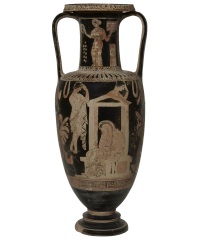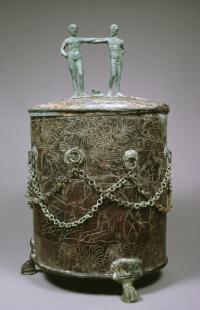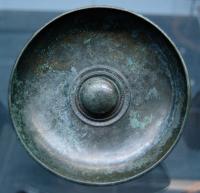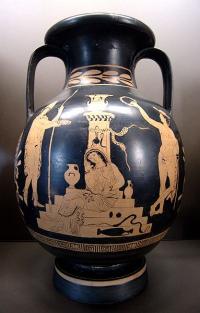Mourning figure seated at a naiskos (small temple designating a tomb)
Learn more about the object below
The dancing woman on the neck of this amphora holds a wreath in her left hand and a cista in her right. Cistas were metal chests with religious and worldly significance, as illustrated by this example with the story of Paris and Helen of Troy from the Walters Museum. They contained unguents and other objects for mystery cults and also held jewels, mirrors, and toiletries for ancient women. Metalworkers engraved elaborate designs along the sides of cistas and embossed images were further defined with white pigments pushed into the furrows.
The mourning woman on the front of this amphora who raises her hand to her head in grief sits at the base of a naiskos. Naiskoi were grave markers carved to resemble temple façades. An image placed between the columns often commemorated the dead, as seen in this illustration showing a young warrior who died in battle. Relatives often visited the graves and left gifts for their deceased loved ones. The naiskos on this amphora was once decorated with a chain of wreathes, whose faint outlines are now barely visible.
The narrative scene on this amphora provides us with a window into ancient traditions of burial and grieving. The seated man on the back of the vase holds a phiale, a shallow bowl used to pour libations for deities and the dead. Phiales were made from various media, ranging from bronze, silver, and gold to terracotta for the less opulent, and were often elaborately decorated. Most phiale have a central knob representing the omphalos, the mythical navel of the world.
The illustration on this amphora may be inspired by the Greek tragedian Aeschylus’s drama, The Libation Bearers, a reference that appears on other vase paintings of this period. In the tragedy, a young woman named Electra visits the tomb of her father and discovers her long-lost brother Orestes and his friend Pylades. A vase in the Louvre, shown in this image, alludes to the same scene. It also demonstrates the practical use of vases in mourning traditions, illustrating vessels that decorate the tomb both to the right and left of the central mourning figure.
Label text by Kelsey LeClair (MHC ’11).
Suggested reading:
Taplin, Oliver. Pots and Plays: Interactions between Greek Tragedy and Vase Painting of the 4th century BC. Malibu: J. Paul Getty Museum, 2007.






